
Jack Anderson
Ratmansky’s Balletic Tributes
Lincoln Center Festival
Mariinsky Ballet (formerly the Kirov Ballet)
Metropolitan Opera House, Lincoln Center
July 11-16, 2011 (closed)
Reviewed by Jack Anderson, July 23, 2011
The brief New York engagement by the venerable Mariinsky Ballet of St. Petersburg was a season of balletic tributes. Each work offered paid homage to someone or something, the most important honoree being the contemporary Russian composer Rodion Shchedrin, who turns 80 next year. There were two full-evening ballets with scores by him, as well as a double-bill pairing Alberto Alonso’s melodramatic “Carmen Suite”(to a score by Shchedrin based on Bizet’s opera) with some unadulterated Bizet, George Balanchine’s familiar “Symphony in C.”
Both multi-act productions were by Alexei Ratmansky, today’s most talked-about young Russian choreographer. Both were tributes to Russian literature. “Anna Karenina” derived from Tolstoy’s masterpiece, while “The Little Humpbacked Horse” was based on a fairytale by Pyotr Yershov (1816-1869) which, although unfamiliar to English readers, is considered a classic in Russia.
The versatile Ratmansky is best known in America for his plotless ballets. But he also has narrative gifts, which were delightfully evident in “The Bright Stream,” a rollicking comedy, created for the Bolshoi Ballet, which proved a hit when staged by American Ballet Theater this spring.
 |
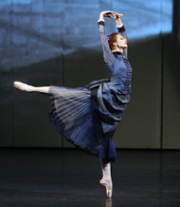 |
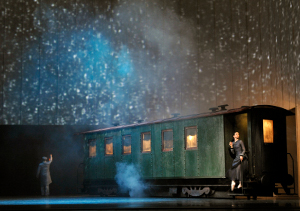 |
| Islom Baimuradov as Alexei Karenin. Photo by Stephanie Berger. | Yekaterina Kondaurova as Anna Karenina. Photo By Natasha Razina. | Scene from Anna Karenina. Photo by Stephanie Berger. |
The tragic “Anna Karenina” disappointed, for it was a tale dully told. Ballets inspired by literature need not copy their sources literally: the plots simply serve as springboards for fresh flights of invention. Nevertheless, narratives and characterizations should be clear. “Anna Karenina” is essentially about passion and adultery, subjects that lend themselves to dance treatment. But Ratmansky had difficulty establishing situations and characters. Several scenes were only vaguely comprehensible (perhaps he tried to include too many of Tolstoy’s details), and people seemed made of cardboard, rather than flesh-and-blood. That could even be said of Anna and her lover Vronsky (Yekaterina Kondaurova and Andrei Yermakov on the night I attended). Everyone went through the proper motions to Shchedrin’s moody music, but the motions lacked excitement.
What made the production watchable were the scenic designs by Mikael Melbye and video projections by Wendall Harrington. Together, they created constantly shifting theatrical landscapes filled with fog and falling snow in which exteriors blended with interiors, furniture slid in and out, and trains came and went (fatally at the conclusion). If the choreography had been stronger, these fluid designs would have intensified the hallucinatory atmosphere. Instead, they called attention to the choreography’s vagueness. It is sometimes said of visually spectacular but musically weak musical comedies, “You can’t hum the scenery.” Well, you can’t dance the scenery, either.
Fortunately, all the components of “The Little Humpbacked Horse” blended harmoniously. The work may be something of a mess, yet it’s a charming one. The late Selma Jeanne Cohen, a dance historian who knew Russian, enjoyed telling people that the ballet’s title can also be rendered as “The Humpbacked Horsie.” I, too, like that translation, for it suggests some of the work’s childlike nature.
“Horsie” has had an eventful history. Yershov’s fairytale came to the stage in 1864 with choreography by Arthur Saint-Léon and music by Cesare Pugni. Over the years, this version was revised by other choreographers and various musical pieces were added to and subtracted from it. In 1960 the ballet received a complete makeover with new choreography by Alexander Radunsky and a new score by Shchedrin, the score that now accompanies Ratmansky’s production which dates from 2009.
Although the action-packed plot is complicated, it is far easier to follow on stage than in the printed synopsis. Yet audiences unfazed by figuring out, say, “The Lord of the Rings” on the movie screen should have little trouble with “Horsie,” in which Ivan, the scorned youngest of three brothers, proves cleverer than anyone else. After many adventures, he rescues a precious ring from the bottom of the sea and weds a beautiful Tsar Maiden, saving her in the process from having to marry a dithery old Tsar, who eventually gets boiled in a cauldron. That plot detail may explain why Yershov’s text occasionally bothered tsarist censors. (It might also worry more recent autocrats.) The good deeds are accomplished with the aid of a Humpbacked Horse who, like Ivan, is considered something of a fool, and yet is infinitely resourceful. The large cast includes other horses, sea creatures, courtiers, Gypsies, and a whole flock of firebirds. A lot does go on: perhaps too much, for the ceaseless jollity occasionally threatens to grow wearisome. Nevertheless, there are many felicitous moments, especially for the leading characters, moments when Ratmansky humanizes what could easily be mere cartoon-like figures.
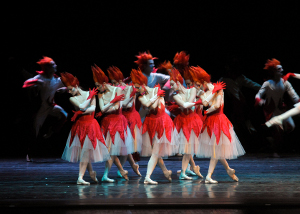 |
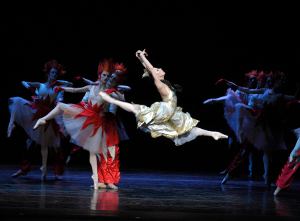 |
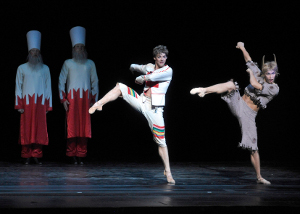 |
| Members of the Mariinsky Ballet as Firebirds. Photo by Stephanie Berger. | Viktoria
Tereshkina as Tsar-Maiden. Photo by Stephanie Berger. |
(L) Vladimir Shklyarov as Ivan the Fool and (R)Vasily Tkachenko as the Humpbacked Horse. Photo by Stephanie Berger. |
It was a particular pleasure to watch Vladimir Shklyarov as Ivan, Viktoria Tereshkina as the Tsar Maiden, and Vasily Tkachenko as the Humpbacked Horse. Tkachenko pranced like an equine Puck. Tereshkina was the loveliest of princesses. And the guileless-looking Shklyarov let his jumping-jack virtuosity display his irrepressible cleverness. Particularly endearing were wistful little hops backward in a solo for Tereshkina by which she revealed her character’s essential gentleness, and some deliberately gauche steps for Shklyarov’s Ivan which Ratmansky’s choreography made him repeat several times until he got them right. (Of course, we all knew he would get them very right indeed.)
Shchedrin’s score seemed indebted to several generations of Russian classical music, recalling at times the Romanticism of Tchaikovsky, the exoticism of Rimsky-Korsakov, and the melancholy of Prokofiev. Shchedrin honored his precedents well. Some people might call this the balletic equivalent of movie music. But that’s no cause for complaint. Good movie music can do much to heighten situations, emotions, and characterizations. Good ballet music does that, too.
Ratmansky, Shchedrin, and Maxim Isayev, who designed the bright geometrical sets, were obviously out to evoke the wonder of fairytales and, despite some long-winded moments, they managed to make their “Horsie” fun.
| museums | NYTW mail | recordings | coupons | publications | classified |
